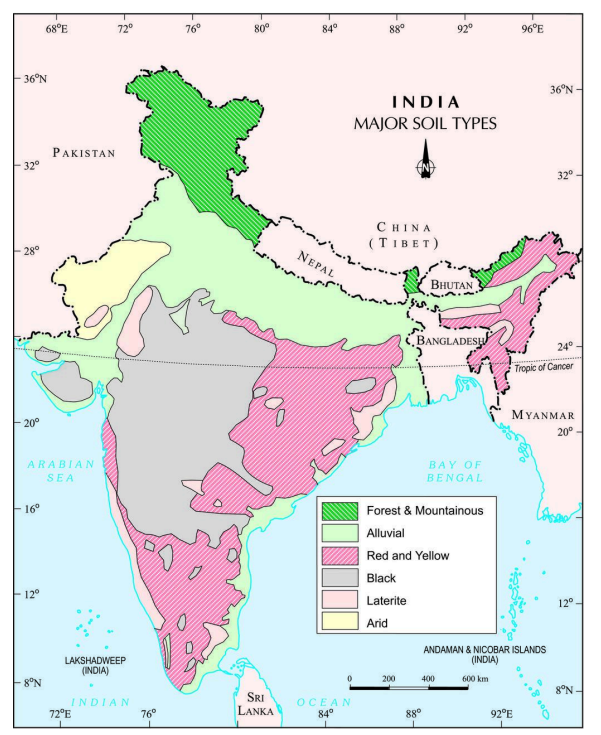
India’s soil types, classified by color, reveal distinct chemical and mineral traits crucial for agriculture and ecology. Red soils, rich in iron, get their color from ferric oxide, supporting crops like cotton and wheat in areas like Tamil Nadu and Karnataka. Black soils, abundant in calcium carbonate, magnesium, and potash, are ideal for cotton cultivation, found in regions like Maharashtra and Madhya Pradesh. Yellow soils, formed under intense leaching, contain low nitrogen and humus but are suitable for crops like pulses and oilseeds, seen in parts of West Bengal and Odisha. Laterite soils, reddish due to high iron and aluminum, are good for plantation crops like tea and coffee, prevalent in Kerala and Karnataka. Each soil type, with its unique chemical makeup, influences the agricultural practices and livelihoods in different parts of India.
Contents
Introduction:
Soil, the foundation of agriculture, varies across India in color, texture, and composition. This diversity allows for the classification of soil types based on color, each possessing specific chemical and mineral characteristics influencing agricultural productivity.
Body

Classification of Soils:
- Red Soil:
○ Color: Red due to ferric oxide presence.
○ Location: Southern and eastern Deccan Plateau, Odisha, and Chhattisgarh.
○ Chemical Characteristics: Rich in iron and aluminum, low in nitrogen and phosphorus.
○ Mineral Characteristics: High clay content, kaolinite, and quartz minerals. - Black Soil (Regur or Cotton Soil):
○ Color: Black due to titaniferous magnetite.
○ Location: Predominantly Deccan Plateau, Maharashtra, Madhya Pradesh, Gujarat, Karnataka, and Andhra Pradesh.
○ Chemical Characteristics: Rich in calcium carbonate, magnesium carbonate, potash, and lime.
○ Mineral Characteristics: Clay minerals like montmorillonite, poor in organic matter. - Laterite Soil:
○ Color: Reddish-brown due to iron oxide.
○ Location: Highland areas of Western Ghats, Eastern Ghats, and Northeast India.
○ Chemical Characteristics: High in iron and aluminum oxides, poor fertility.
○ Mineral Characteristics: Laterite minerals, used in construction due to hardness. - Yellow Soil:
○ Color: Yellow due to hydrated ferric oxide.
○ Location: Eastern and southern regions, including Orissa, Chhattisgarh, and the Western Ghats.
○ Chemical Characteristics: Low in nitrogen, phosphorus, and organic matter.
○ Mineral Characteristics: Rich in kaolinite and quartz, less fertile than black soils. - Alluvial Soil:
○ Color: Varies from light to ash grey.
○ Location: Indo-Gangetic plains, Punjab, Haryana, Uttar Pradesh, Bihar, and West Bengal.
○ Chemical Characteristics: Rich in potash, phosphoric acid, and varying nitrogen content.
○ Mineral Characteristics: Composed of silt, clay, sand, highly fertile. - Desert Soil:
○ Color: Ranges from red to brown.
○ Location: Arid regions of Rajasthan and Gujarat.
○ Chemical Characteristics: Poor in organic matter, high in soluble salts, alkaline.
○ Mineral Characteristics: Sandy with low clay content, contains gypsum and salts.
Conclusion:
Understanding the nuances of soil types in India is pivotal for sustainable agricultural practices. By leveraging the unique chemical and mineral characteristics of each soil type, farmers can implement tailored strategies to enhance soil fertility, optimize crop selection, and ensure long-term agricultural prosperity.
In case you still have your doubts, contact us on 9811333901.
For UPSC Prelims Resources, Click here
For Daily Updates and Study Material:
Join our Telegram Channel – Edukemy for IAS
- 1. Learn through Videos – here
- 2. Be Exam Ready by Practicing Daily MCQs – here
- 3. Daily Newsletter – Get all your Current Affairs Covered – here
- 4. Mains Answer Writing Practice – here

